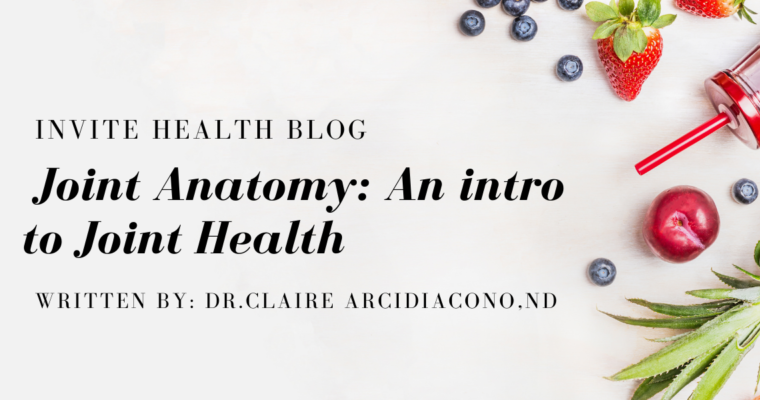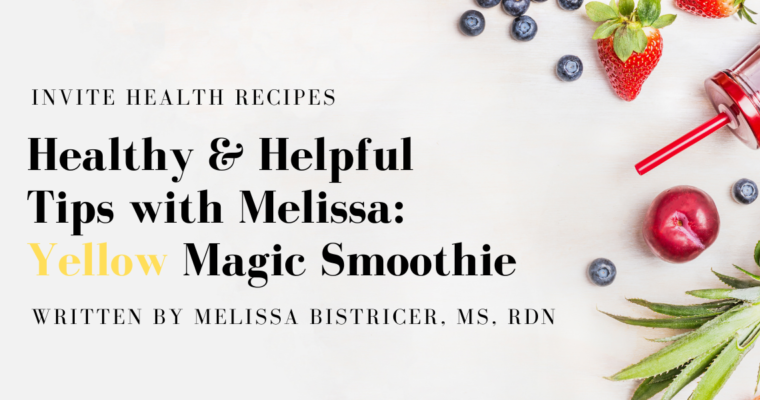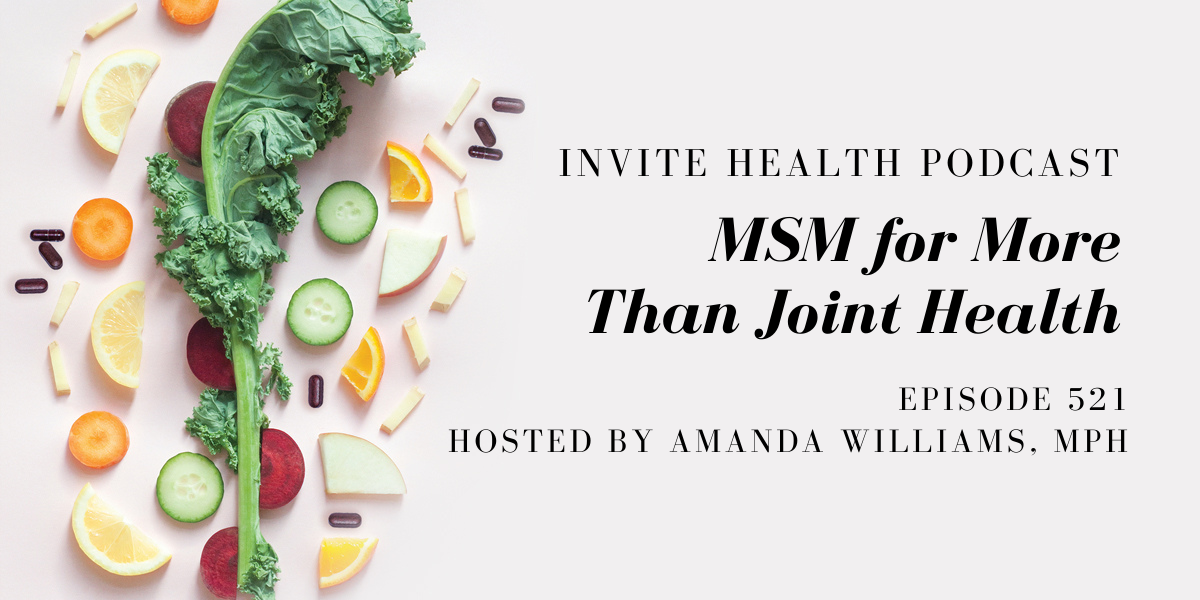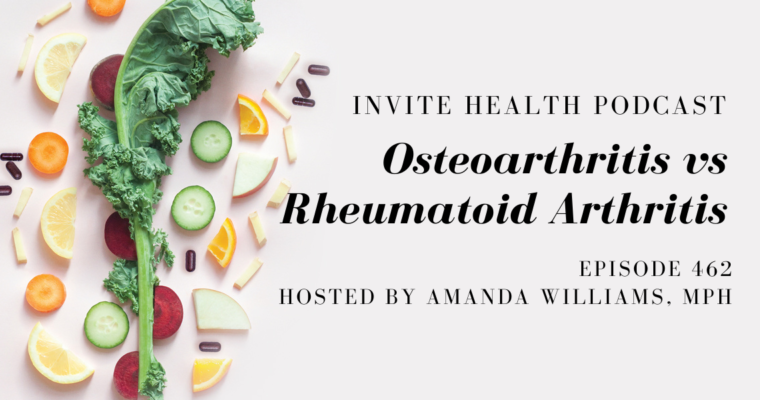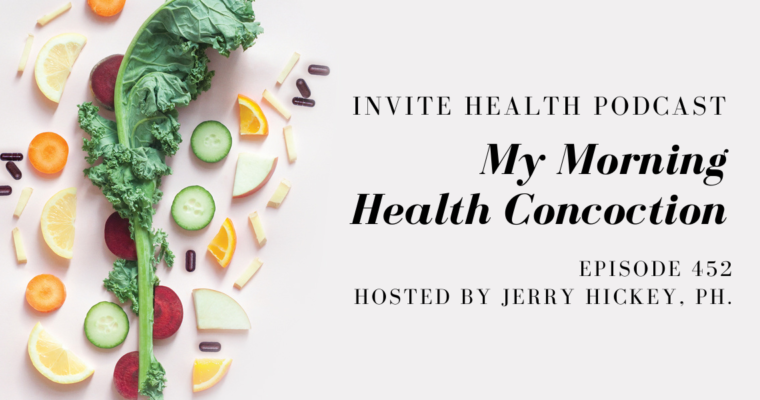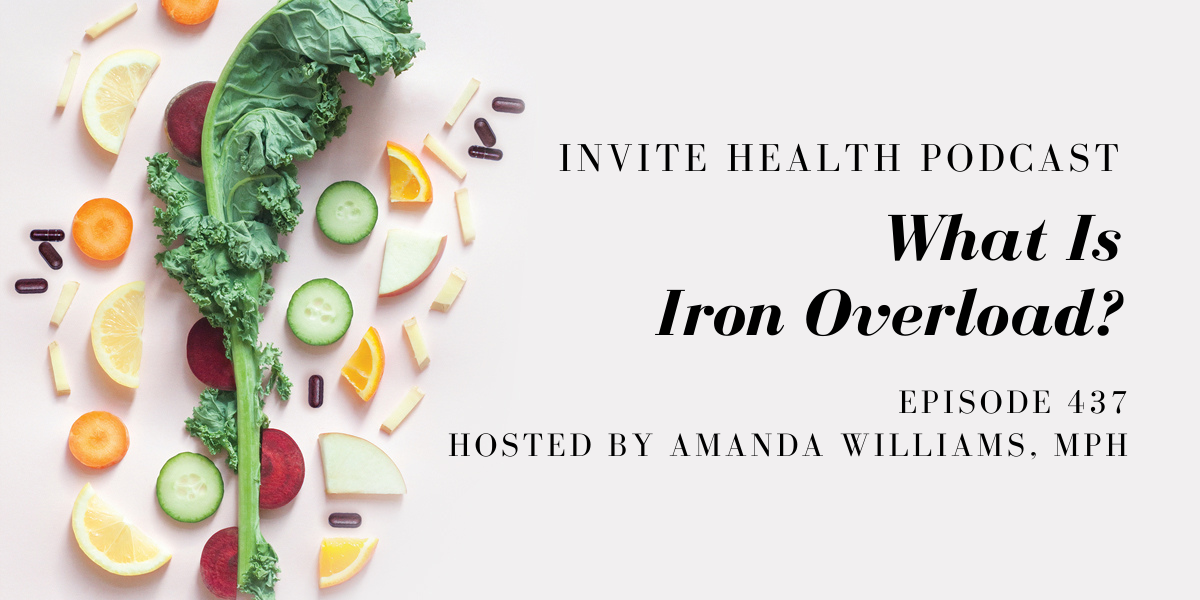MSM
Subscribe Today!
Please see below for a complete transcript of this episode.
MSM for More Than Joint Health – InViteⓇ Health Podcast, Episode 521
Hosted by Amanda Williams, MPH
*Intro music*
InViteⓇ Health Podcast Intro: Welcome to the InViteⓇ Health Podcast, where our degreed healthcare professionals are excited to offer you the most important health and wellness information you need to make informed choices about your health. You can learn more about the products discussed in each of these episodes and all that InViteⓇ Health has to offer at www.invitehealth.com/podcast. First time customers can use promo code PODCAST at checkout for an additional 15% off your first purchase. Let’s get started!
*Intro music*
Amanda Williams, MPH:
[00:00:40] You’ve probably heard people talk about the use of MSM when it comes to joint health, and certainly we know that MSM can be incredibly beneficial when it comes to easing inflammation and targeting a lot of the discomfort that goes along with a stiff, achy knee, for example. But we also recognize that this natural compound in the human body does many other actions, and I want to talk about that today. So I’m Amanda Williams, MD, MPH, and MSM. This is very interesting because when we think about compounds or active constituents that are in the body, we oftentimes recognize that as we get older, sometimes we don’t make things as efficiently. Well, MSM happens to fall into that category once again.† [00:01:26]
[00:01:26] And another big problem with MSM in terms of having inadequate exposure to MSM in order to build up more is because of the diet and dietary intake. So natural food sources of MSM, for the most part, is coming from vegetables. And we know that most Americans do not take in enough vegetables. So when you look at things like cauliflower and kale and cabbage, brussels sprouts, these are really wonderful sources of MSM. But because many Americans just don’t get enough kale throughout the week, or perhaps alfalfa sprouts are just not your thing, well, then we want to be thinking about why we would want to be supplementing with MSM.† [00:02:14]
[00:02:15] So let’s talk about what it actually is. It’s a natural substance that we make in the body, but we also ingest this in foods, of course. We know that the body uses it to treat pain and to target inflammation. So this is why you will see this in our joint formulation. Because when we think about the different reasons as to why, as we get older, our joints can start to feel a bit on the the achy side. I would say you get up in the morning and maybe your your knee feels incredibly stiff until you get moving around. Well, we have to recognize maybe I’m not getting enough MSM in my diet and perhaps taking MSM as a supplement would be very beneficial. So we know that it is doing that. We know that it’s very geared towards the health of our joints and supporting the cartilage and the collagen and the tendons that make up our joints. But we also know that it is a powerful antioxidant in its own right. Now what exactly does MSM stand for? That’s the shortened version because the actual name of it is methylsulfonylmethane. So most people aren’t going to say methylsulfonylmethane. So we just shortened it to, to MSM.† [00:03:33]
A SUPERIOR CARTILAGE NUTRIENT FOR JOINT COMFORT – INVITE HEALTH PODCAST, EPISODE 38. Listen Now>>
[00:03:34] But what’s really quite fascinating is over the course of the past probably two decades, a lot of research has gone into looking at how MSM is actually working in multiple different systems, including when we think about our skin and aging skin is a area that has a profound amount of interest and research because nobody wants to look older than they are or feel like they’re getting, you know, more fine lines or deep wrinkles. People are always trying to avoid this, trying to find that magic serum that’s out there. So they did a study and they published this back in 2020. And this was interesting because there had been other studies leading up to this one that had shown MSM has a key structural reason as to why we’re seeing this in the skin. And they talk about how it’s helping with the hydration from the inside out. So the study that was published in the International Journal of Vitamin Research started to recognize that when people were supplementing with MSM, for example, for the health of their joints, they started to see this significant shift or improvement when it came to the minimization or the reversal of aging in the skin. So say, if you had a lot of facial wrinkles with a crow’s feet, maybe your skin, you felt like it was a little saggy, not as firm as it once used to be, so that elasticity. Maybe your skin felt a bit more on the dried out side. They found that supplementation with MSM started to make major shifts in all of these different parameters. And they concluded that MSM was effective in reducing visual signs of skin aging even at low doses. So they were looking at roughly about 1000mg per day of MSM could start to potentiate these multiple benefits outside of that of the joint. And I think that this is an area that many times we overlook. I talk about this with hyaluronic acid as well. We know that when people are supplementing with hyaluronic acid to support the cushioning in their joints, many times they start to see the real benefit when it comes to the health of their skin. So we see this with MSM as well.† [00:06:03]

[00:06:03] Now we know that MSM also has immunomodulatory properties to it, meaning that it can help the way in which our immune system is actually responding and reacting. And this is key because if we, you know, get the common cold or we’re exposed to a particular, say, a bad bacteria, a staph infection, something along that line, we know that MSM is actually helping to normalize a healthier and more active immune system response. We can look at how it can help to support the cardiovascular system and the integrity of those vessels, so you’re getting more adequate blood supply throughout the system. And of course, we can look at it for its main reason, which is when we think about joint health and the inflammation that occurs in the joint that dries up all of that pain.† [00:07:03]
[00:07:04] So in the Journal of Nutrients in 2017, they go into all of the many different applications of MSM, and they talk about how it’s become an incredibly popular dietary supplement, and most people are using it as an anti-inflammatory agent, they describe it as. They said we know that it’s doing many other things. So this naturally occurring compound that for many people, they’re not getting enough adequate exposure from their diet and when the body starts to kind of taper off its own current production, then you can start to see greater levels of inflammation or perhaps more severe aging of the skin or worsening of high blood pressure. So they started to look at all of the ways to which MSM would be beneficial as part of a daily supplementation routine. So they said that the absorption rate of MSM when you’re taking it from your foods or via supplementation, which will yield you a much higher amount, can be very, very helpful for many areas in the body outside of just thinking of the joints. So when they think about the cross-talking of cytokines and prostaglandins, these things that regulate or create inflammation in the body, they started to see that MSM was actually working to disrupt those pathways to which, how inflammation is driving in the body. So hence the anti-inflammatory component of MSM has been shown. They can see specifically the different biomarkers that MSM is targeting things like NF-kappa beta and tumor necrosis factor alpha. I mention these not because you necessarily need to know what they are, but they are two of the master drivers for inflammation in the human body.† [00:09:05]
[00:09:06] We can also see how it’s working to support this nitric oxide release. I talked about the vascular integrity, so thinking about the structure of our blood vessels. But we also see that MSM can help to release nitric oxide, which allows for that relaxation of your blood vessels and hence better blood flow. We know that it has its own powerful antioxidants. So for free radicals that we’re continuously exposed to, we can see the specific pathways to which the antioxidants contained in MSM are really working to regulate or balance our body’s ability to stay protected against all of these reactive oxygen species, as we call them. And then when it comes to the immune system and the modulation of the immune system, this is working in a couple of different mechanisms. Number one with that, you know, maintaining a healthy immune system response. Part of that comes down to the inflammation process, too. So we already know that MSM very targeted towards regulating inflammation in the body. But then we can also look at the support of the vascular system, which can also be tied in with our immune system.† [00:10:31]
BEETS HX: THE ULTIMATE PRE-WORKOUT ROUTINE – INVITE HEALTH PODCAST, EPISODE 282. Listen Now>>
[00:10:32] We know that MSM also is key when we think about the way our body detoxifies. And so when we think about the methylation pathways that occur, we understand much more now about this incredibly unique, naturally occurring compound in the human body. Beyond that of for arthritis and for inflammation, which of course, is what most people recognize it for, you know, for the preservation of your cartilage to help to have better range of motion when you think about your knee, when you think about your hip, or maybe your shoulder, for example. But now we also see that it’s working even when it comes to inflammation in the airways when people have seasonal allergies. They’ve been able to do studies showing that that moisture because of its support for the vascular system and its ability to minimize inflammation can be helpful even in that setting of an allergic response. And of course, for most people, the concern when it comes to what we see on the outside, which is the aging appearance of the skin. And since there have been multiple studies and they started looking at this back in the, probably in the 1980s, 1990s is when they really started to see how much MSM was required when it came to healthy skin aging. In the absence of MSM is when you started to see more significant degree of wrinkling where you started to see a more significant loss of elasticity. We usually always just, you know, think about things like collagen and Vitamin C and even hyaluronic acid, but now we understand that MSM is also playing a big role in this.† [00:12:31]
[00:12:32] Then you can look at many different research studies that have looked at the impact of MSM when it comes to supporting proper cell division, even in the setting of cancer. So MSM incredibly multi-functional outside of that of just enhancing the health of your joints. When you’re utilizing MSM as a supplement, you’re supporting cardiovascular health, you’re supporting immune system health, you are supporting the health of your skin and so much more.† [00:13:05]
[00:13:06] So that’s all that I have for you for today. I want to thank you so much for tuning in to the InViteⓇ Health Podcast. Remember, you can find all of our episodes for free wherever you listen to podcasts or by visiting invitehealth.com/podcast. Now do make sure that you subscribe and you leave us a review. You can follow us on Facebook, Twitter and Instagram @invitehealth and we will see you next time for another episode of the InViteⓇ Health Podcast.† [00:13:06]
*Exit music*


